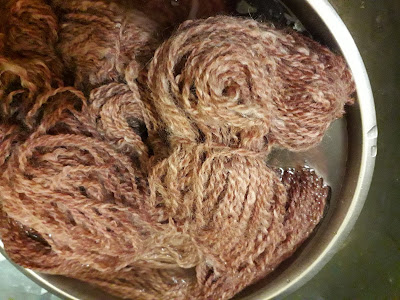During our conversations over lockdown, she suggested using it to dye wool and offered it to me. I jumped online to do some research.
Most blogs and videos showed people putting wool directly into red wine and boiling it. The resulting colour was so faint it was barely pink. Some mentioned using a mordant. I'd heard of mordants with natural dyes and always been a little afraid of it. I didn't really understand the process or exactly what I should use or where to get it. Google is my friend.
I learned that the word mordant comes from the Latin mordere meaning 'to bite'. The use of a mordant allows the colour to 'bite' into the fabric or fibre being dyed. Often, what we use as a natural dye is more of a stain than a dye. The resulting colour is unlikely to be colourfast or lightfast. It is usually faint and will fade. Mordanting opens up the fibre and allows it to grab more of the colour.
For more on the process, including step by step instructions for different fibres, I recommend this site.
Alum (Aluminium potassium sulfate) is the best mordant for wool. Adding citric acid or cream of tartar to the mordant bath keeps the wool soft and may deepen some dyes. I found some quite reasonably priced at Hands Ashford and ordered online.
Meanwhile I was spinning madly. I had been given some Romney fleece and it was spinning up beautifully. My alum arrived. I weighed two skeins and started them soaking before mordanting. I measured out my alum and citric acid and started my dye bath in an old aluminium stockpot that I have used for dyeing before.
I'm always a bit iffy about boiling wool. I'm afraid it will make my wool brittle. I heated it to a simmer and turned it off. After an hour or so, I heated it some more and left it to cool overnight. I had read in a couple of places that I could wrap it wet in a towel, roll it up and leave it for 2-5 days. But I wasn't sure if I should rinse it first. At first I couldn't find the original instructions I'd read. They were all telling me to rinse and dry and then dye. My rough instructions from Hands mentioned rolling it damp in a towel, but didn't mention rinsing.
I found the instructions I'd been looking at originally, don't rinse. The point is to allow the mordant to soak more thoroughly into the wool and 'curing' it this way makes for a better dye job.
I got some gloves on and squeezed most of it out of the wool and laid it out on a towel.
By the time we dropped to level 3 and I was able to go and visit my sister (still keeping distance of course), I had three towels or six skeins curing. I reused my mordant five times, just adding 10% more alum and citric acid each time.
I worried a little about what I would use for a dye bath. My usual dye pot was still in daily use for mordanting. But since wine is effectively a foodstuff, I decided it would be safe to use my cooking stockpot. I put two skeins in and covered them in wine.
 |
| It rather looks like minced beef though. |
I heated this to a simmer and let it cool a little and repeated the process. Pretty much like the mordant. I checked it every now and then to see how much the wine colour had soaked in. Pouring a little water over some exposed wool shows how much washes off.
I left it overnight before washing and rinsing. I used a very small amount of laundry powder and washed and rinsed until the water was coming out clear.
I wrung it out and laid it out on a clotheshorse to dry.
The big bonus I noticed in dyeing with wine is that it can be reused for the next batch. When I've used acid exhaust dyes, you know when the dye is done because all the colour is in the wool and the bath has almost clear water. This doesn't happen with wine.
I am quite pleased with the colour. It has come out darker than I expected, but not as bright as I'd hoped. Still it's quite pretty. Coming up next is coffee dyeing.






No comments:
Post a Comment